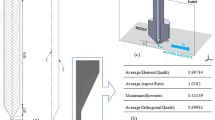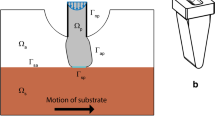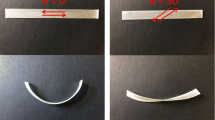Abstract
In this study, the process of thermoplastic material deposition during 3D printing has been investigated via a multiphysics approach, using numerical and experimental tools. Namely, through computational fluid dynamics modeling, details of the flow structure and heat transfer process of the deposited material from the nozzle head onto the bed have been investigated. Experimental trials were conducted to validate the results of the computational model, and a good conformity between the results was obtained, with error less than 8%. Both curling and fluid mechanical swing machine print patterns were captured, especially given the high-viscosity and non-Newtonian characteristics of the flow. In particular, in the conducted case on ABS, results indicated that the ratio of the extrudate diameter to the nozzle diameter is around 12%. At feed rates lower than 100 mm/min, the curling takes place, where the extruded material bends up against the direction of the injection at the nozzle. It was observed that the fluid mechanical swing machine pattern takes place at the feed rate-to-moving bed speed ratios higher than 1.0, and depending on the nozzle to bed gap. High fidelity numerical platforms are deemed critical to better comprehend and predict complex local phenomena taking place during fused filament fabrication, and accordingly to more reliably optimize the process parameters.














Similar content being viewed by others
References
The Third Industrial Revolution. The Economist, https://www.economist.com/leaders/2012/04/21/the-third-industrial-revolution, 2012.
A. Altinkaynak, M. Gupta, M.A. Spalding and S.L. Crabtree, Melting in a Single Screw Extruder: Experiments and 3D Finite Element Simulations, Int. Polym. Process., 2011, 26(2), p 182–196.
ANSYS Technical Documentation, ANSYS-CFX Commercial Software, 2017.
J.U. Brackbill, D.B. Kothe and C. Zemach, A Continuum Method for Modeling Surface Tension, J. Comput. Phys., 1992, 100(2), p 335–354.
P. Brun, N.M. Ribe and B. Audoly, A Numerical Investigation of the Fluid Mechanical Sewing Machine, Am. Inst. Phys., 2012, 24(4), p 1–37.
H.H. Chiang, A Unified Simulation of the Filling and Postfilling Stages in Injection Molding Part I: Formulation, Polym. Eng. Sci., 1991, 31(2), p 116–124.
S. Chiu-Webster and J.R. Lister, The Fall of a Viscous Thread onto a Moving Surface: A “Fluid-mechanical Sewing Machine,” J. Fluid. Mech., 2006, 569, p 89–111.
D.R. Eyers and A.T. Potter, Industrial Additive Manufacturing: A Manufacturing Systems Perspective, Comput. Ind., 2017, 92–93, p 208–218.
M. Iliescu, E. Nutu and B. Comanescu, Applied Finite Element Method Simulation in 3D Printing, Int. J. Mathm. Comput. Simul., 2008, 2(4), p 305–312.
M.M.K. Khan, R.F. Liang, R.K. Gupta and S. Agarwal, Rheological and Mechanical Properties of ABS/PC Blends, Korea-Australia Rheol J., 2005, 17(1), p 1–7.
M. Kumar, P. Karan and S. Verma, Numerical Simulation of Rep-Rap 3D Printer Liquefier to Determine the Thermal Behavior of Heat Sink, Int. J. Sci. c Res. Dev., 2017, 5(1), p 92–101.
M.H. lbrahim, Melt Flow Behavior of Polymer Matrix Extrusion for Fused Deposition Modeling (FDM), Appl. Mech. Mater., 2014, 660, p 89–93.
X.-L. Luo and E. Mitsoulis, Memory Phenomena in Extrudate Swell Simulations for Annular Dies, J. Rheol. (N Y N Y)., 1989, 33(8), p 1307–1327.
N. Mostafa, H.M. Syed, S. Igor and G. Andrew, A Study of Melt Flow Analysis of an ABS-Iron Composite in Fused Deposition Modelling Process, Tsinghua Sci. Technol., 2009, 14, p 29–37.
S. Negi, S. Dhiman and R.K. Sharma, Basics, Applications and Future of Additive Manufacturing Technologies: a Review, J. Manuf. Technol. Res., 2012, 5(1), p 1–23.
M. Nikzad, S.H. Masood and I. Sbarski, Thermo-mechanical Properties of a Highly Filled Polymeric Composites for Fused Deposition Modeling, Mater. Des., 2011, 32(6), p 3448–3456.
S.R. Owen and J.F. Harper, Mechanical, Microscopical and Fire Retardant Studies of ABS Polymers, Polym. Degrad. Stab., 1999, 64(3), p 449–455.
D.D. Phan, J.S. Horner, Z.R. Swain, A.N. Beris and M.E. Mackay, Computational Fluid Dynamics Simulation of the Melting Process in the Fused Filament Fabrication Additive Manufacturing Technique, Addit. Manuf., 2020, 33, p 101161.
H.S. Ramanath, C.K. Chua, K.F. Leong and K.D. Shah, Melt Flow Behaviour of Poly-e-caprolactone in Fused Deposition Modelling, J. Mater. Sci. Mater. Med., 2008, 19(7), p 2541–2550.
N.M. Ribe, M. Habibi and D. Bonn, Liquid Rope Coiling, Annu. Rev. Fluid Mech., 2012, 44(2), p 249–266.
J.F. Rodríguez, J.P. Thomas and J.E. Renaud, Mechanical Behavior of Acrylonitrile Butadiene Styrene Fused Deposition Materials Modeling, Rapid. Prototyp. J., 2003, 9(4), p 219–230.
S.E. Solovyov, T.L. Virkler and C.E. Scott, Rheology of Acrylonitrile – Butadiene – Styrene Polymer Melts and Viscoelastic Constitutive Models. J. Rheol. (N Y N Y), 1999, 977(43), p 977–990.
Y. Zhang and Y.K. Chou, Three-dimensional Finite Element Analysis Simulations of the Fused Deposition Modelling Process. Proc. Inst. Mech. Eng. Part. B J. Eng. Manuf., 2006, 220(10), p 1663–1671.
Acknowledgment
The first author would like to thank Mr. Randy Venberg, President of Global Heat Transfer Ltd., and Dr. Hamidreza Zarei Rajani, R&D Manager at Global Heat Transfer Ltd., for their support and positive discussions toward fundamentals of the studied phenomena in complex heat and material transfer systems. The authors would also like to highly acknowledge Mr. Bryn Crawford and Mr. Kurt Yesilcimen from UBC for their valuable assistance during the experiments.
Author information
Authors and Affiliations
Corresponding author
Additional information
Publisher's Note
Springer Nature remains neutral with regard to jurisdictional claims in published maps and institutional affiliations.
This invited article is part of a special topical focus in the Journal of Materials Engineering and Performance on Additive Manufacturing. The issue was organized by Dr. William Frazier, Pilgrim Consulting, LLC; Mr. Rick Russell, NASA; Dr. Yan Lu, NIST; Dr. Brandon D. Ribic, America Makes; and Caroline Vail, NSWC Carderock.
Rights and permissions
About this article
Cite this article
Jahandardoost, M., Milani, A.S. Multiphysics Modeling and Experimental Investigation of the Deposition Process in Fused Filament Fabrication Method, under High-Viscosity and Non-Newtonian Material Flow. J. of Materi Eng and Perform 30, 6913–6923 (2021). https://doi.org/10.1007/s11665-021-06061-z
Received:
Revised:
Accepted:
Published:
Issue Date:
DOI: https://doi.org/10.1007/s11665-021-06061-z




